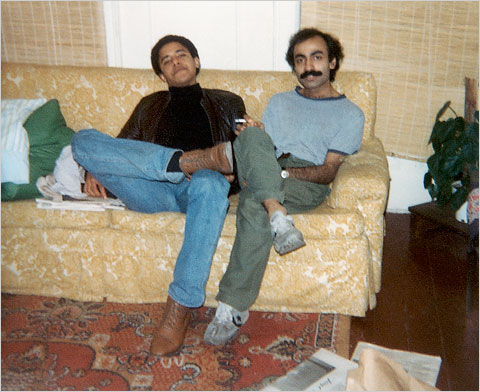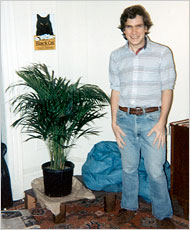Given that he was an announced candidate for president, and an underdog at that, the Times expected Obama to welcome the chance to reconcile his account in his memoir, “Dreams from My Father,” with the accounts of those who knew him.
“Yet,” lamented the newly neutered Times, “he declined repeated requests to talk about his New York years, release his Columbia transcript or identify even a single fellow student, co-worker, roommate or friend from those years.”
A campaign spokesman, Ben LaBolt, offered a painfully lame explanation for Obama’s reticence, “He doesn’t remember the names of a lot of people in his life.”
Lame or not, it worked, and it continues to work on a media that have spent more time in the dumpsters of Wasilla than they have investigating the preposterously unknown history of the world’s best-known man.
When the media leave holes in a given narrative – in this case, the biography of a presidential candidate – bloggers individually, incrementally and indefatigably strive to fill them in, usually with mixed results.
One hole that remains strangely unfilled in that narrative is the academic year 1981-1982, a year Obama was reportedly a student at Columbia University.
The irrepressible researcher Orly Taitz secured a document through the National Student Clearinghouse on Obama’s Columbia attendance.
The document confirms Obama’s graduation from Columbia with a political science degree in 1983, but it places him there only in the 1982-1983 academic year.
“As there is no record of Obama residing anywhere else in the United States from September 1981-September 1982, or attending any other university,” Taitz infers, “by way of simple deduction it becomes clear that his visit to Pakistan lasted not a month or two, as he claims, but over a year.”
Obama’s deceptions and studied opaqueness invite such speculation, but Taitz is likely unaware of competing evidence. How valid that evidence is remains to be seen.
Going back, Occidental friend John Drew confirms seeing Obama at a party in Los Angeles in June 1981. “At that time,” says Drew, “the future president was a doctrinaire Marxist revolutionary, although perhaps – for the first time – considering conventional politics as a more practical road to socialism.”
In “Dreams,” Obama gives no account of the following summer. He moves from Los Angeles to New York in August and allegedly lands roughly. No one was present at his Spanish Harlem sublease when he arrives, and Obama sleeps in an alleyway.
Desperate, Obama calls “Sadik,” a Pakistani and his one friend in the city, who just happens to be a coke-head and an illegal alien.
When Obama gives up his apartment because of a lack of heat, he and Sadik – in real life, Sohale Siddiqi – move in together, the date unspecified.
Gulag Note: “Barack Obama with a friend, Sohale Saddiqi, in the fall of 1981
(All photos courtesy of Phil Boerner)” in article by Alison Leigh Cowan,
in obambi.wordpress.com
(All photos courtesy of Phil Boerner)” in article by Alison Leigh Cowan,
in obambi.wordpress.com
(Comment from another person who knew Obama as a young man, "Also, this photo illustrates other themes I've communicated regarding the young Obama including the fact that I never saw him with a girl and that he was strikingly effeminent at the time".) John C. Drew, Ph.D. is an award-winning political scientist.
By contrast, Obama devotes considerable attention to an alleged trip to Europe a few years later, his flimsy account of which seems to have been pulled from a Michelin Guide.
In fact, it was not until April 2008 at a San Francisco fundraiser that Obama casually let it be known that he had traveled to Pakistan at all, an admission that took his own spokesman by surprise.
There was likely a reason for this impromptu admission. Two weeks earlier, an employee of John Brennan, a former CIA operative then advising Obama, accessed Obama’s passport on three occasions.
The CNN lead suggests a major story in the making, “The CEO of a company whose employee is accused of improperly looking at the passport files of presidential candidates is a consultant to the Barack Obama campaign, a source said Saturday.”
The story predictably went nowhere despite the fact that Obama would later appoint Brennan deputy national security adviser.
The most benign explanation is that Team Obama was doing oppositional research on its own candidate – and likely the other candidates as well – and that Obama outed himself on a questionable trip to a Muslim country before the real opposition did.
Remnick spends less than a page on the Pakistan trip, which he describes, as Obama has, as sort of a stop-over to see friends on the way to visit his mother and sister in Indonesia.
Securing a visa for this trip in 1981 was apparently possible for an American but not easy. Although Remnick interviews Obama’s friends about the Pakistan leg, he gives no accounting of Obama’s stay in Indonesia, if, in fact, there was one.
Writing in 2009, Remnick has to accommodate new information that surfaced post-election about Obama’s life once he descended on New York after his Asian junket.
In “Dreams,” Obama had chosen not to. To make the narrative of the brooding, father-seeking ascetic work, he had to scrub one person out of the record, Occidental friend Phil Boerner.
As Boerner tells it, he transferred with Obama to Columbia and roomed with him his first year in New York in that same Spanish Harlem apartment. There is no mention of a character anything like him in “Dreams.”
A registered Democrat and Obama fan, Boerner conveniently laid low until well after the 2008 election. Wrote Boerner in January 2009:
“We enjoyed exploring museums such as the Guggenheim, the Met and the American Museum of Natural History, and browsing in bookstores such as the Strand and the Barnes & Noble opposite Columbia. We both liked taking long walks down Broadway on a Sunday afternoon, and listening to the silence of Central Park after a big snow.”
What makes Boerner problematic for the Obama narrative is his very normality. This obliging middle-class guy from suburban D.C. makes Obama sound so thoroughly cheerful and white that he throws into question the alleged sturm und drang of Obama’s New York years.
“Hanging out, we could get pretty emotional about sports, food and injustice,” writes Boerner, who nicely captures liberal priorities then and now.
The Marxist dandy that John Drew had met at Occidental did not transform himself when he came to New York. The transformation to morally serious philosophe would come later, but only at the hands of Bill Ayers and largely in the pages of “Dreams.”
“Like a tourist, I watched the range of human possibility on display,” writes Obama of those years, “trying to trace out my future in the lives of the people I saw, looking for some opening through which I could re-enter.”
Re-enter what? This seems more the reflection of a soon to be ex-fugitive than that of a metro-sexual happily browsing the Met. Ayers, by the way, uses the phrase “human possibility” twice in his memoir, “Fugitive Days.”
Not surprisingly, Boerner has chosen not to return my phone call. As I said on his voice mail, all I wanted to do was clarify whether Obama actually attended class his first year in New York.
You would think we would know this by now.
.
 Jack Cashill is the author of numerous books which reveal important facts about the powerful and their sometimes clandestine power moves. Deconstructing Obama is his latest, released this February.
Jack Cashill is the author of numerous books which reveal important facts about the powerful and their sometimes clandestine power moves. Deconstructing Obama is his latest, released this February. He is also an independent writer and Emmy winning producer, and has written for Fortune, The Wall Street Journal, The Washington Post, The Weekly Standard, American Thinker, also regularly for WorldNetDaily. Jack may be contacted at Cashill.com.
Article originally published in WorldNetDaily.







No comments:
Post a Comment